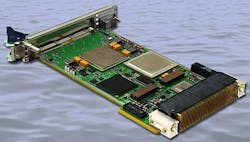3U VPX FPGA-based DSP card for radar, SIGINT, ISR, and EW introduced by Curtiss-Wright
ASHBURN, Va., 30 Oct. 2012. Curtiss-Wright Controls Defense Solutions in Ashburn, Va., is introducing the VPX3-453 Xilinx Virtex-6 field-programmable gate array (FPGA)-based 3U VPX digital signal processing (DSP) engine for demanding radar processing; signals intelligence (SIGINT); intelligence, surveillance, and reconnaissance (ISR); image processing; and electronic warfare (EW) applications.
The VPX3-453 is a small form factor DSP engine that combines a Xilinx Virtex-6 FPGA and a Freescale Power Architecture MPC8640D processor. This small-form-factor VITA 46/48 card is for SWaP-constrained environments and operates in temperatures from -40 to 85 degrees Celsius.
The VPX3-453 features Gen 2 PCI Express with non-transparent bridge support for large 3U systems. The board includes 2.4-gigabyte-per-second SDRAM and 4.8-gigabyte-per-second SRAM solid-state memory. FPGA memory support includes one bank of DDR2 SDRAM and two banks of QDR-II+ SRAM.
Two 4-lane high-speed serial ports to the backplane and an additional port to the XMC site provide a total of 7.5-gigabyte-per-second bandwidth into and out of the FPGA in addition to the primary 4-lane PCI Express link to the on-board fabric.
Software support for the VPX3-453 includes VxWorks or Linux. To ease and speed application development, Curtiss-Wright also offers its Continuum FXTools FPGA design kit.
For more information contact Curtiss-Wright Controls Defense Solutions online at www.cwcdefense.com.
